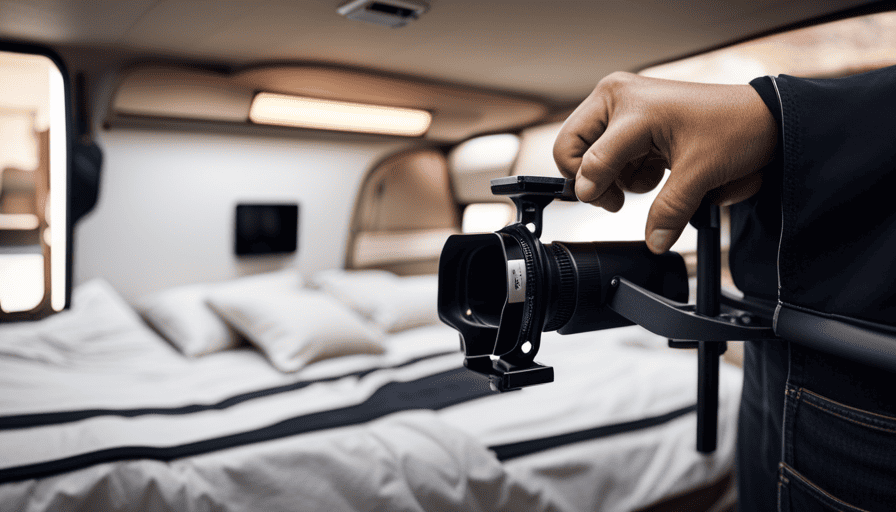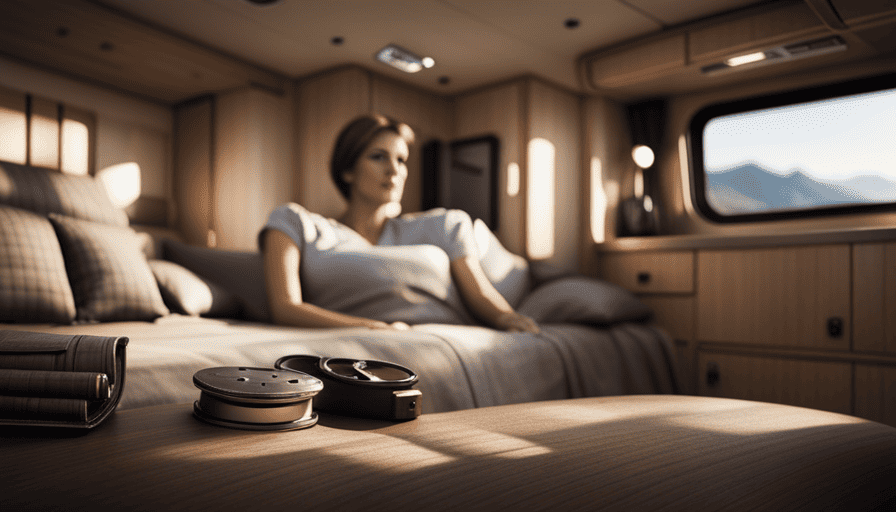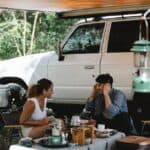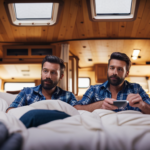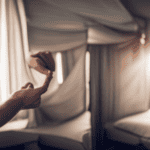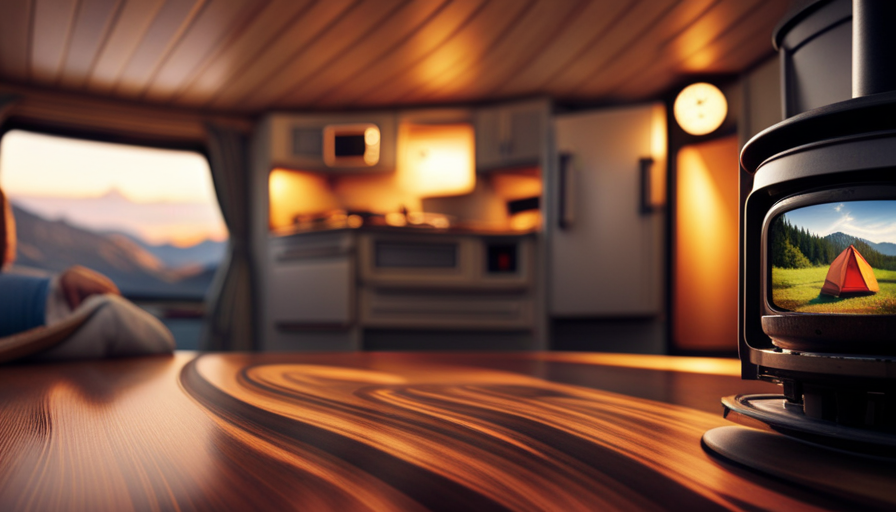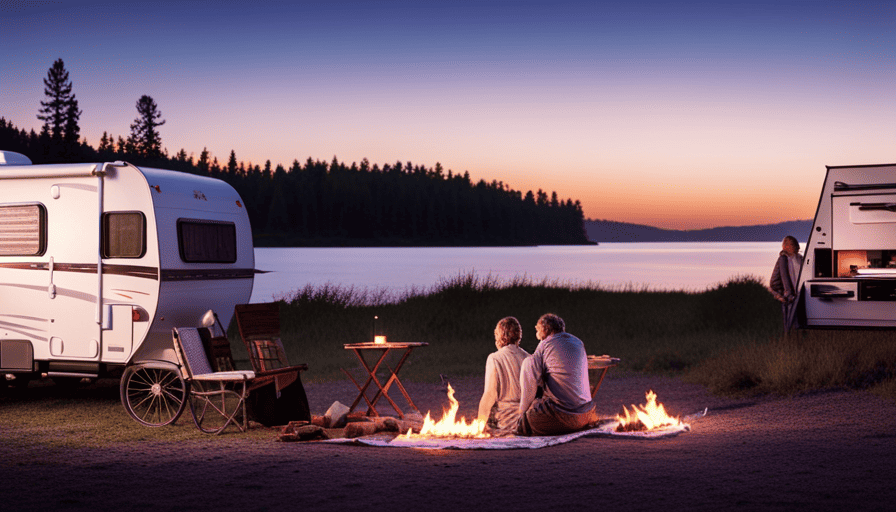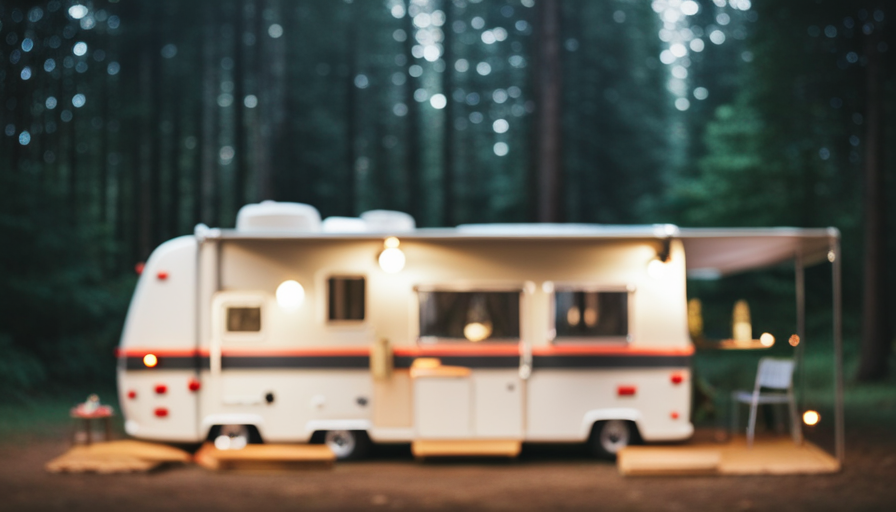The adage ‘Home is where you hang your TV’ resonates deeply for many of us who find joy in traversing new territories and embrace the nomadic lifestyle with our campers as our homes. However, being constantly on the go doesn’t imply that you must forgo enjoying your beloved TV programs and films.
In this article, I’ll show you step-by-step how to hang a TV in your camper, so you can enjoy your entertainment on the go.
First, you’ll need to assess your camper’s space and requirements to determine the right TV size and type for your needs. Then, you’ll need to consider the mounting options available and gather the necessary tools and materials.
Once you have everything you need, it’s time to find a suitable mounting location and attach the TV to the mounting bracket. Don’t forget to test the stability and adjust the viewing angle to ensure the best viewing experience.
Finally, you’ll want to secure the cables and wires to keep everything neat and organized. With these simple steps, you’ll be able to enjoy your favorite shows and movies while on the road in your camper. So, let’s get started and make your camper feel like home, wherever you go!
Key Takeaways
- Assess space and requirements to determine the right TV size and type.
- Consider mounting options and gather necessary tools and materials.
- Find a suitable mounting location and attach the TV to the mounting bracket.
- Secure cables and wires for a neat and organized setup.
Assess Your Camper’s Space and Requirements
Now that you’re ready to add a TV to your camper, take a moment to assess your space and figure out what requirements you’ll need to meet.
Explore alternative storage solutions to make sure you have enough room for the TV. Look for areas where the TV can be mounted securely, such as on a wall or the ceiling. Assess the structural integrity of these potential mounting locations to ensure they can support the weight of the TV.
Consider the size and layout of your camper when determining the ideal TV size. Measure the available space where you plan to mount the TV and choose a size that fits comfortably. Keep in mind that larger TVs may be more challenging to mount and may take up more space. Additionally, consider the type of TV that will work best for your camper. LED TVs are often a popular choice due to their energy efficiency and slim design.
Now that you’ve assessed your camper’s space and requirements, it’s time to move on to choosing the right TV size and type.
Choose the Right TV Size and Type
First, make sure you’ve selected the perfect size and type of television for your camper, so you can enjoy your favorite shows while on the road. Choosing the right TV size for your camper is crucial to ensure optimal viewing experience without compromising on space. Here are some tips to help you make the right choice:
-
Consider the available space in your camper and measure the area where you plan to mount the TV. This will help you determine the maximum size that’ll fit comfortably.
-
Take into account the viewing distance. If you’ve limited space, a smaller TV might be more suitable.
-
Understand the different types of TVs available for camper use. LED TVs’re popular for their energy efficiency, while OLED TVs offer superior picture quality.
-
Consider the power requirements of the TV. If you’re camping off-grid, a TV with low power consumption’d be ideal.
-
Look for features such as built-in DVD players or USB ports, which can enhance your entertainment options in the camper.
Now that you’ve chosen the perfect TV size and type for your camper, it’s time to consider the mounting options.
Consider the Mounting Options
One important aspect to consider when setting up your camper’s entertainment system is exploring the various options for mounting your television. There are different types of TV mounts that you can choose from, each with their own pros and cons. Here is a table that provides a comparison of the most common TV mounts used in campers:
| Mount Type | Pros | Cons |
|---|---|---|
| Fixed Mount | – Provides a secure and stable hold for the TV – Keeps the TV close to the wall, saving space |
– Limited flexibility in adjusting the viewing angle – Difficult to access the cables behind the TV |
| Tilting Mount | – Allows you to adjust the viewing angle up or down – Provides easy access to cables |
– Limited side-to-side swivel – May not be suitable for tight spaces |
| Articulating Mount | – Offers the most flexibility in adjusting the viewing angle – Provides easy access to cables – Allows for easy TV positioning in different areas of the camper |
– Can be more expensive than fixed or tilting mounts – Requires more installation and setup time |
Considering the pros and cons of each mount type is crucial in determining the best option for your camper. Once you have chosen the appropriate mount, you can then gather the necessary tools and materials to proceed with the installation.
Gather the Necessary Tools and Materials
To get started on your camper’s entertainment system, make sure you’ve got all the tools and materials you need at hand. Choosing the right tools is crucial to ensure a successful TV installation.
You will need a stud finder to locate the wooden framing inside the walls. This will help you find a secure spot to mount your TV. Additionally, you’ll need a drill and appropriate drill bits to create pilot holes for the mounting screws. Understanding the weight capacity of your camper’s walls is also important. Make sure to check the manufacturer’s guidelines to determine the maximum weight your walls can support. This will ensure that you choose a TV mounting bracket that is suitable for your camper.
It’s also a good idea to have a level on hand to ensure that your TV is mounted straight.
With all the necessary tools and materials gathered, you can now move on to finding a suitable mounting location for your TV, which we will discuss in the next section.
Find a Suitable Mounting Location
Now let’s discover the perfect spot to effortlessly install your TV in your mobile home! Finding the perfect placement for your TV is crucial in ensuring a secure and stable mount in your camper. You want to choose a location that provides optimal viewing angles while considering the structural integrity of your camper’s walls. To help you find the best spot, consider the following factors:
| Factors to Consider | Suitable Placement |
|---|---|
| Viewing angles | Eye level or adjustable mount for optimal viewing experience |
| Structural integrity of walls | Reinforced areas or use a stud finder for secure mounting |
| Cable management | Access to power outlets and cable routing options |
By considering these factors, you can find a suitable location that meets your needs. Once you’ve determined the perfect spot, you can proceed to install the mounting bracket. This transition will ensure a seamless continuation of the process, allowing you to securely mount your TV in your camper.
Install the Mounting Bracket
After selecting the perfect spot, it’s time to get your hands dirty and attach the mounting bracket. The first step is to gather all the necessary tools and equipment.
You’ll need a drill, screws, a stud finder, and a level. Start by locating the studs in the wall using the stud finder. Once you have determined the stud locations, mark them with a pencil. This will ensure a secure and stable mount.
Next, hold the mounting bracket against the wall, aligning it with the stud marks. Use a level to make sure it’s straight. Once you’re satisfied with the placement, use a drill to attach the bracket to the wall using the screws. Make sure to tighten the screws firmly to ensure a secure fit.
If you don’t have access to studs, there are alternative mounting methods available. You can use toggle bolts or wall anchors to secure the bracket to the wall. However, it’s important to note that these methods may not be as strong and stable as mounting directly into studs.
Now that the mounting bracket is securely installed, it’s time to move on to the next step: attaching the TV to the mounting bracket.
Attach the TV to the Mounting Bracket
Once the mounting bracket is securely in place, it’s time to connect your television to it. Attaching the TV to the mounting bracket is a crucial step in ensuring a secure and stable installation. To make sure your TV is securely attached, follow these steps:
- Position the TV in front of the mounting bracket, making sure it aligns with the mounting holes.
- Carefully lift the TV and slide it onto the bracket, ensuring that the mounting screws on the back of the TV align with the holes on the bracket.
Once aligned, gently lower the TV onto the bracket, making sure it sits flush against the wall.
- Use a screwdriver to tighten the screws on the mounting bracket, securing the TV in place.
By following these steps, you can ensure that your TV is securely attached to the mounting bracket, minimizing the risk of it falling or becoming unstable.
After attaching the TV, the next step is to test the stability and adjust the viewing angle to ensure optimal comfort and visibility.
Test the Stability and Adjust the Viewing Angle
To ensure a secure and comfortable viewing experience, it’s important to test the stability and adjust the viewing angle of your TV after attaching it to the mounting bracket. Adjusting the viewing angle is crucial because it ensures that everyone can enjoy a clear and unobstructed view of the screen.
Imagine you’ve just installed your TV in your living room. You want to make sure that the viewing angle is perfect for watching movies with your family, so you carefully adjust the tilt and swivel features of the TV mount. By doing this, you can ensure that everyone can see the screen clearly from their seating positions.
Testing the stability is equally important to prevent any accidents or damage to the TV. You can gently shake the TV to check if it wobbles or feels loose. If it does, you may need to tighten the mounting screws or make adjustments to ensure a stable and secure installation.
Once you have tested the stability and adjusted the viewing angle, the next step is to secure the cables and wires, ensuring a neat and organized setup.
Secure the Cables and Wires
Now it’s time to tidy up those cables and wires, ensuring a sleek and organized setup. Cable management is essential in a camper, as it not only keeps the area neat but also prevents any potential accidents or damage. Here are a few tips to help you with wire organization:
-
Use cable ties or Velcro straps to bundle the cables together. This will keep them neat and prevent them from tangling.
-
Consider using cable clips or adhesive hooks to secure the cables along the walls or furniture. This will prevent them from dangling and getting in the way.
-
Label the cables using cable tags or colored tape. This will make it easier to identify each cable and avoid confusion when unplugging or rearranging them.
-
If possible, route the cables behind the walls or furniture to keep them out of sight. This will give your setup a cleaner and more professional look.
By following these cable management techniques, you can create a tidy and organized space for your TV setup in the camper. With all the cables secured and organized, you can now enjoy your favorite shows and movies on the road!
Enjoy Your Favorite Shows and Movies on the Road!
Kick back, relax, and indulge in the joy of your beloved shows and movies wherever your journey takes you! One of the best things about hanging a TV in your camper is having access to a wide range of RV entertainment options.
With the right setup, you can enjoy all your favorite shows and movies while on the road. To make the most of your TV in the camper, it’s important to choose the best streaming services for on-the-go viewing. There are several options available that offer a variety of content and features suitable for RVers.
Some popular streaming services include Netflix, Hulu, and Amazon Prime Video, which all offer a wide selection of movies and TV shows that can be enjoyed straight from your TV.
In addition to these mainstream streaming services, there are also options specifically designed for RVers, such as RVezy TV and RVillage TV. These services offer RV-specific content, including travel shows, documentaries, and tips for life on the road.
To access these streaming services, you will need a reliable internet connection. Many campgrounds offer Wi-Fi, but it’s always a good idea to have a backup plan, such as a mobile hotspot or a satellite internet service.
So, whether you’re lounging in your camper after a long day of exploring or finding entertainment during a rainy day, having a TV in your camper opens up a world of entertainment possibilities. Don’t miss out on the latest episodes of your favorite shows or the opportunity to discover new movies while on the road!
Frequently Asked Questions
How do I determine the weight capacity of the mounting bracket?
To determine the weight capacity of a mounting bracket, you should refer to the manufacturer’s specifications. Look for the maximum weight the bracket can support, which is usually listed in pounds.
This information is crucial for ensuring that the bracket can safely hold your TV. It’s important not to exceed the weight limit, as doing so could lead to a dangerous situation where the TV falls and gets damaged.
Always prioritize safety when choosing a mounting bracket.
Can I use a regular household TV in my camper?
Yes, you can use a regular household TV in your camper. To power it, you can use a portable generator as a power source.
As for mounting options without using a bracket, there are a few alternatives. You can use a wall mount that screws directly into the wall, a TV stand with adjustable height, or a portable TV mount that clamps onto a stable surface. These options provide flexibility and convenience when setting up your TV in a camper.
How do I secure the TV during travel to prevent damage?
To secure the TV during travel and prevent damage, I recommend using a TV mount specifically designed for RVs. These mounts have features like locking mechanisms and adjustable angles to keep the TV stable during movement.
Additionally, using a foam pad or cushioning material behind the TV can provide extra protection. It’s important to secure all cables and power cords as well.
By taking these precautions, you can ensure your TV stays safe and secure while on the road.
What kind of tools and materials will I need for the installation?
Tools needed for installing a TV in a camper include a stud finder, a level, a drill, a screwdriver, and a measuring tape.
Materials required include a TV mount or bracket, screws, wall anchors (if needed), and a power drill.
It’s important to choose a TV mount that’s appropriate for the size and weight of your TV. Make sure to follow the manufacturer’s instructions and always secure the TV mount to a stud in the wall for stability.
How do I hide the cables and wires for a clean and organized look?
To achieve a clean and organized look, hiding cables and wires is crucial. One effective solution is using cable management systems. These systems are designed to conceal and organize your cables, keeping them out of sight.
You can use cable raceways or wire hiders to neatly tuck away the cables along the walls or behind furniture. Additionally, cable sleeves and cable clips can help keep the cables organized and prevent them from tangling.
Conclusion
In conclusion, hanging a TV in a camper is a practical and enjoyable way to enhance your on-the-road experience. By assessing your camper’s space and choosing the right TV size, you can create a comfortable and entertaining environment. Consider mounting options and gather the right tools and materials. Find a suitable location and attach the TV, making sure to secure cables. With these steps, you can enjoy your favorite shows and movies while exploring new destinations. So, hit the road and let your TV be the window to a world of entertainment!

